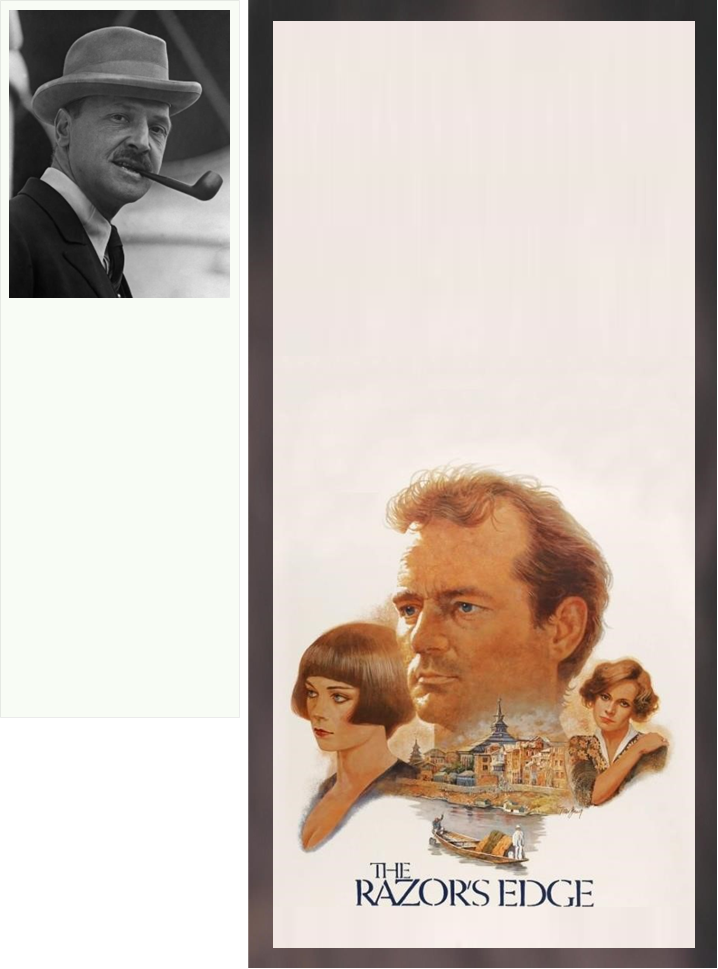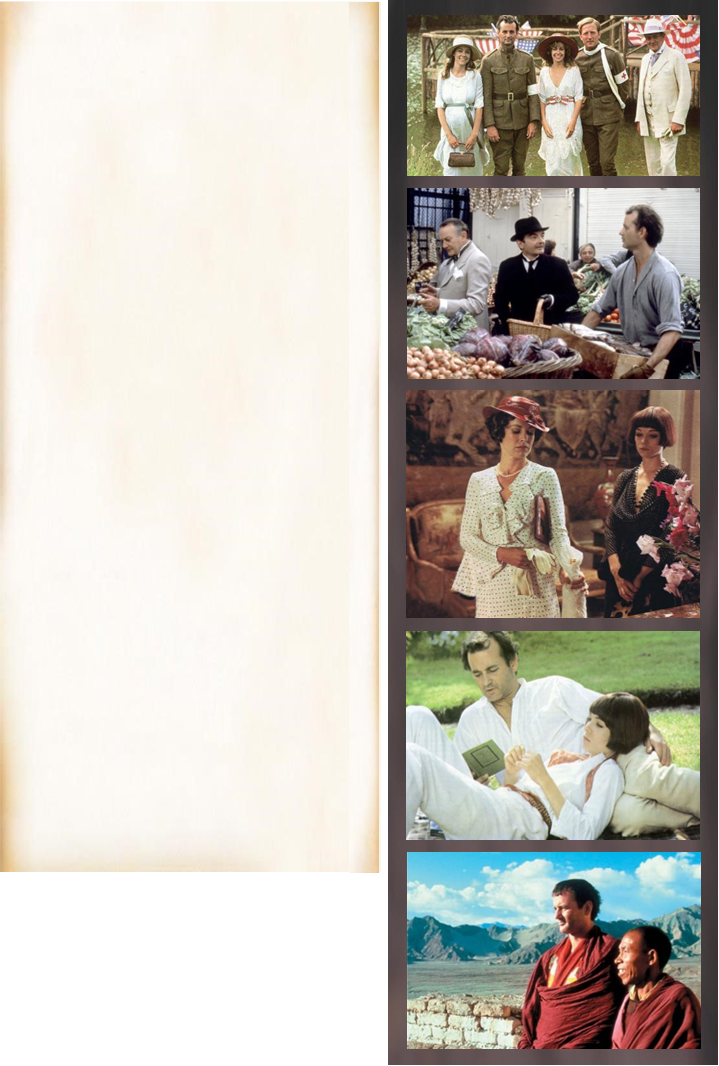Робочий аркуш (a worksheet): "The Razor's Edge by Somerset Maugham"
Literature
THE RAZOR’S EDGE by WILLIAM SOMERSET MAUGHAM
ABOUT THE AUTHOR
Somerset Maugham, in full William Somerset Maugham (1874—1965), an English novelist, playwright, and short -story writer whose work is characterized by a clear unadorned style, cosmopolitan settings, and a shrewd understanding of human nature.
Maugham was orphaned at the age of 10; he was brought up by an uncle and educated at
 King’s School, Canterbury. After a year at Heidelberg, he entered St. Thomas’ medical school, London, and qualified as a doctor in 1897. He drew upon his experiences as an obstetrician in his first novel, Liza of Lambeth (1897), and its success. Though small, encouraged him to abandon medicine. He traveled in Spain and Italy and in 1908 achieved a the atrical triumph — four plays running in London at once — that brought him financial security. During World War I he worked as a secret agent. After the war he resumed his interrupted travels and, in 1928, bought a villa on Cape Ferrat in the south of France, which became his permanent home. In January 1938 William Somerset Maugham visited Sri Ramanashram for a few hours. The brief contact he had with Bhagavan inspired Maugham so much, he decided to use him as the model for a fictional Guru in The Razor’s Edge, a novel of his that was published a few years later in 1944.
King’s School, Canterbury. After a year at Heidelberg, he entered St. Thomas’ medical school, London, and qualified as a doctor in 1897. He drew upon his experiences as an obstetrician in his first novel, Liza of Lambeth (1897), and its success. Though small, encouraged him to abandon medicine. He traveled in Spain and Italy and in 1908 achieved a the atrical triumph — four plays running in London at once — that brought him financial security. During World War I he worked as a secret agent. After the war he resumed his interrupted travels and, in 1928, bought a villa on Cape Ferrat in the south of France, which became his permanent home. In January 1938 William Somerset Maugham visited Sri Ramanashram for a few hours. The brief contact he had with Bhagavan inspired Maugham so much, he decided to use him as the model for a fictional Guru in The Razor’s Edge, a novel of his that was published a few years later in 1944.
![]() The eastern philosophy, popularized by W. Somerset Maugham in this 1944 novel, had a profound impact on American and British culture in the decade’s following the book’s publication .
The eastern philosophy, popularized by W. Somerset Maugham in this 1944 novel, had a profound impact on American and British culture in the decade’s following the book’s publication .
TASK A. Read the text about the author and answer the following questions:
1. What is William Somerset Maugham famous for?
2. Where did William Somerset Maugham live?
3. How did the eastern philosophy influence the author and his works? What impact did it have on the readers?
TASK B. Read the text about the story and answer the following questions:
1. What is the significance of the novel's title and epigraph? 'The sharp edge of a razor is difficult to pass over; thus the wise say the path to Salvation is hard.'
What does the proverb mean, and how does it compare to the Christian belief in salvation — is it similar or dissimilar?
2. Has Larry travelled along the razor's edge? Has he achieved salvation? Does he, at least, find what he's looking for?
ABOUT THE STORY
The Razor’s Edge is concerned in large part with the search for the meaning of life and with the dichotomy between materialism and spirituality. Set in Chicago, Paris, and India in the 1920s and ’30s, the novel involves characters from sharply different worlds. The main focus of the story is on Larry Darrell, who has returned from service as an aviator in World War I utterly rejecting his prewar values. He is concerned chiefly with discovering the transcendent meaning of human existence and eliminating evil in the world. To that end, he spends five years in India seeking — but not finding — answers.
Through the eyes of the narrator, who happens to be a minor character and a writer, the readers follow Larry’s both spiritual and literal journey.
A veteran, with good connections and a sharp mind, Larry could easily go into business and start making money just like his friends, but he turns down one good opportunity after another. In an attempt to clarify what his plans are, his bride Isabel asks him directly. Larry’s intention is to go to Paris and try to gain needed knowledge. So he and Isabel decide to marry later.
Almost two years later, Isabel breaks off the engagement and marries Gray, who has an appropriate social position and money. Soon enough the youn g pair becomes parents. Unlike his friends, who almost all settle down, Larry travels. Almost ten years pass before they all meet again.
After Larry’s return, Isabel’s old feelings are rekindled. Her husband Gray has a hard time, for his family business is destroyed with the economic decline.
Later on, they meet Sophie, their old childhood friend. Trying to blank the death of her husband and child out, she becomes alcohol and opium addicted. Soon Larry announces that he and Sophie are going to marry. Being aware of Sophie’s struggles to return to a normal life, Isabel plays a dirty trick on her, leaving her alone with a bottle of alcohol. Sophie drinks it all and runs away from Larry and his sanity. At the same very time their friend Elliot dies and leaves a part of his fortune to Isabel, which allows her and Gray to start everything anew. Sophie is found dead and the narrator pays for her funeral. Larry decides that it is time to return back home.
The novel’s title comes from a quotation translated from the Katha Upanishad: ‘Rise, wake up, seek the wise and realize. The path is difficult to cross like the sharpened edge of the razor.’ A thin line separates love from hate, success from failure, life from death; a line is difficult to walk as a razor’s edge.
The story has been adapted for film twice, once in 1946 with starring Tyron Power and again in 1984
with Bill
Murray.
The following extracts are all taken from of 1944 edition of the A novel, Chapter 7 part 2:
<…> I was surprised but supposed that my friend of Madura had told him something about me. But he shook his head when I mentioned his name. I presented my fruit and he told the young man to take it away. We were left alone and he looked at me without speaking. I don’t know how long the silence lasted. It might have been for half an hour. I’ve told you what he looked like; what I haven’t told you is the serenity that he irradiated, the goodness, the peace, the selflessness. I was hot and tbut gradually I began to feel wonderfully rested. Before he’d said another ired after my journey, word I knew that this was the man I’d been seeking. <…>
[Darrel speaking]: ‘I was given as a dwelling place the shack in which Shri
Ganesha had lived in when he now passed both night and day had been built when disciples gathered he first came down to the plain. The hall in which
around him and more and more people, attracted by his fame, came to visit B
him… I read a great deal. I meditated. I listened to Shri Ganesha when he
 chose to talk; he didn’t talk very much, but he was always willing to answer questions and it was wonderfully inspiring to listen to him. It was like music in your ears. Though in his youth he had himself practised very severe austerities he did not enjoin them on his disciples. He sought to wean them from the slavery of selfhood, passion and sense, and told them that they could acquire liberation by tranquillity, restraint, renunciation, resignation, by steadfastness of mind and by an ardent desire for freedom. People used to come from the nearby town three or four miles away, where there was a famous temple to which great crowds flocked once a year for a festival. They came from Trivandrum and from far off places to tell him their troubles, to ask his advice, to listen to his teaching; and all went away strengthened in soul and at peace with themselves. What he taught was very simple. He taught that we are all greater than we know and that wisdom is the means to freedom. He taught that it is not essential to salvation to retire from the world, but only to renounce the self. He taught that work done with no selfish interest purifies the mind and that duties are the opportunities offered to man to sink his separate self and become one with the universal self. But it C
chose to talk; he didn’t talk very much, but he was always willing to answer questions and it was wonderfully inspiring to listen to him. It was like music in your ears. Though in his youth he had himself practised very severe austerities he did not enjoin them on his disciples. He sought to wean them from the slavery of selfhood, passion and sense, and told them that they could acquire liberation by tranquillity, restraint, renunciation, resignation, by steadfastness of mind and by an ardent desire for freedom. People used to come from the nearby town three or four miles away, where there was a famous temple to which great crowds flocked once a year for a festival. They came from Trivandrum and from far off places to tell him their troubles, to ask his advice, to listen to his teaching; and all went away strengthened in soul and at peace with themselves. What he taught was very simple. He taught that we are all greater than we know and that wisdom is the means to freedom. He taught that it is not essential to salvation to retire from the world, but only to renounce the self. He taught that work done with no selfish interest purifies the mind and that duties are the opportunities offered to man to sink his separate self and become one with the universal self. But it C
wasn’t his teaching that was so remarkable; it was the man himself, his benignity, his greatness of soul, his saintliness. His presence was a benediction. I was very happy with him. I felt that at last I had found what I wanted. <…>
<…> [Larry Darrel speaking] ‘It was three or four miles from the nearest town, but people used to come from there, and even from much further, on foot or by bullock car, to hear the Yogi talk when he was inclined to or just sit at this feet and share with one another the peace and blessedness that were radiated from his presence as fragrance was wafted upon the air by a tuberose. <…>
[Darrel in conversation with Maugham, the narrator]
‘In person d’you mean? Well, he wasn’t tall, neither thin nor fat, palish brown in colour and clean shaven, with close-cropped white hair. He never wore anything but a loincloth and yet he managed to look as trim and welldressed as a young man in one of our Brooks Brothers’ advertisements.’
‘And what had he got that particularly attracted you?’ Larry looked at me for a full minute before answering. His eyes in their deep sockets seemed as though they were trying to see to the depths of my soul.
‘Saintliness.’
I was slightly disconcerted by his reply. In that room [in Paris], with its fine furniture, and with those lovely drawings on the walls, the world fell like a plop of water that has seeped through the ceiling from an overflowing bath. D
‘We’ve read all about the saints, St Francis, St John of the Cross, but that was hundreds of years ago. I never thought it possible to meet one who was alive now. From the first time I saw him I never doubted that he was a saint. It was a wonderful experience.’ ‘And what did you gain from it?’
‘Peace.’ He said casually with a light smile.’ <…>
[Darrel speaking again] ‘Everyone knew of him. For many years he’d lived in a cave in the hills, but finally he’d been persuaded to move down to the plain where some charitable person had given him a plot of land and had built a little adobe house for him. It was a long way from Trivandrum, the capital, and it took me all day, first by train and then by bullock cart to get to the ashram. I found a young man at the entrance of the compound and asked if I could see the Yogi. I’d bought with me the basket of fruit which is the customary gift to offer. In a few minutes the man came back and led me into a long hall with windows all around it. In one corner Shri Ganesha sat in an attitude of meditation on a raised dais covered with a tiger skin, ‘I’ve been expecting you,’ he said…
E
|
TASK C. Read the extract from the novel and answer the questions:
1. What is enlightenment [зд. просветление ума]? What is its purpose? 2. Why do people seek it? Is enlightenment the same as salvation? 3. What should a person do to achieve the enlightenment? What exactly purifies a person’s mind, according to passage?
TASK D. Look at the pictures from the film and do the tasks:
1. Put the pictures in chronological order according to the plot. 2. Describe the event each picture shows: who, where and what the people are doing in each picture? 3. Is Isabel a sympathetic character? What did she do with Sophie in Picture C? Larry appears to forgive her at the end. Why?
|

про публікацію авторської розробки
Додати розробку
